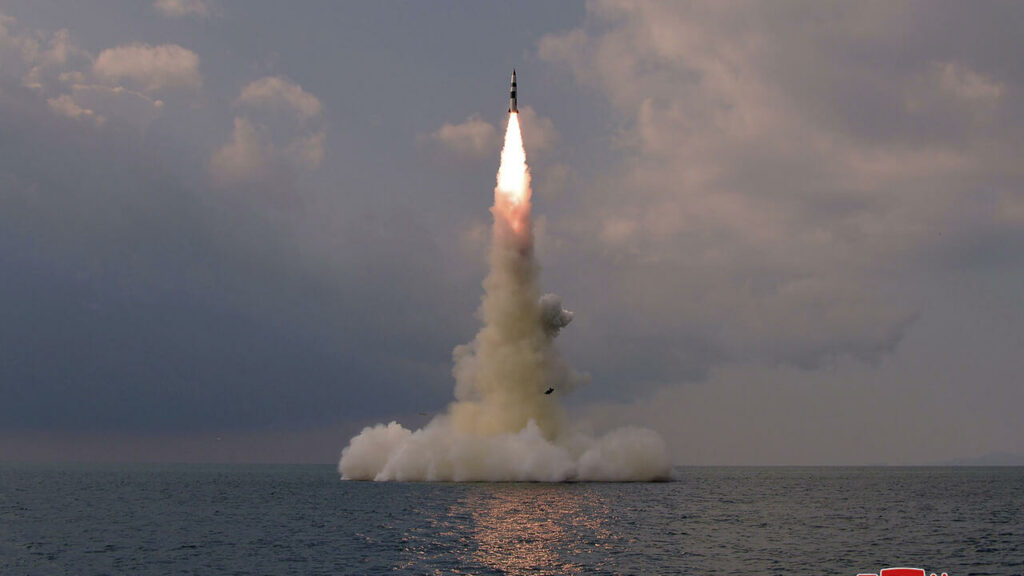Published on :
North Korea launched a new ballistic missile on Saturday, three days before the inauguration of new South Korean President Yoon Suk-yeol, who has promised to get tough on Kim Jong-un’s regime.
North Korea fired a sea-to-ground ballistic missile on Saturday, May 7, announced the South Korean army staff, a few hours after the United States warned of the possibility of a resumption of nuclear tests by Pyongyang in the coming weeks.
This is the 15and show of force this year for this nuclear-armed country which also launched an intercontinental ballistic missile for the first time since 2017.
This new launch comes before the new South Korean President Yoon Suk-yeol takes office on Tuesday, favorable to the balance of power with the North, and accentuates fears of an escalation.
The US State Department warned on Friday that a nuclear test could take place « as early as this month », based on satellite imagery.
>> To read also: « Hwasong-15 or Hwasong-17: would North Korea have faked its last missile launch? »
“Our military detected at around 2:07 p.m. (5:07 GMT) that a short-range ballistic missile suspected to be an SLBM was fired from the sea off Sinpo, South Hamgyong,” the state said on Saturday. South Korean army major in a statement.
Sinpo is an important naval base in North Korea. Satellite images have shown the presence of submarines there in the past.
According to the Japanese Coast Guard, citing their Ministry of Defense, Pyongyang launched an object “likely to be a ballistic missile”.
At a major military parade last week, North Korean leader Kim Jong-un pledged to build up his nuclear forces « as soon as possible » and warned against possible strikes » preventive measures », mentioned by the future South Korean president, Yoon Suk-yeol.
On Friday, Washington, through diplomatic spokeswoman Jalina Porter, warned that Pyongyang « is preparing the Punggye-ri test site and may be ready to conduct a test there as early as this month, which would be its seventh nuclear test.
« This analysis is consistent with recent public statements made by North Korea itself, » she added, assuring that the US government had shared it with its allies and would « continue » its « close coordination with them ».
Joe Biden soon in Tokyo and Seoul
US President Joe Biden is due to visit Japan and South Korea this month, where concerns about Pyongyang will be on the menu.
The latest missile launch could be linked to the visit or Tuesday’s inauguration of Yoon Suk-yeol, who has promised an inflexible line against the North.
« Instead of accepting invitations to dialogue, the Kim regime appears to be preparing to test a tactical nuclear warhead, » said Leif-Eric Easley, a professor at Ewha University in Seoul.
North Korea had conducted six nuclear tests before engaging in high-level diplomacy with the United States, with then-US President Donald Trump meeting Kim Jong-un four times.
« A seventh nuclear test would be the first since September 2017 and would fuel tensions on the Korean peninsula, increasing the dangers of miscalculation and miscommunication between the Kim regime and the future Yoon administration, » Leif-added Eric Easley.
A policy of dialogue without success
South Korea has more conventional weapons capacity than its northern neighbor and Yoon Suk-yeol has called for the deployment of more US military assets.
South Korea tested its own ballistic sea-to-surface missile in 2021, becoming one of the few countries to master this technology. She also unveiled a supersonic cruise missile, highlighting an arms race on the peninsula.
On Wednesday, Pyongyang launched what Seoul and Tokyo described as a ballistic missile, but North Korean state media, which usually reports on the weapons tests, did not report on it.
Hong Min, a researcher at the Korea Institute for National Unification, believed on Saturday that « today’s launch is similar to Wednesday’s ballistic missile. »
“It looks like the North is running a series of tests to achieve its strategic goals,” he added.
Negotiations to convince Kim Jong-un to give up nuclear weapons came to nothing.
For five years, South Korean President Moon Jae-in pursued a policy of dialogue with Pyongyang, but according to his successor, this « servile » approach was a clear failure.
According to analysts, Kim Jong-un could want to warn, by this series of tests, that he is not open to a dialogue with the new government.
With AFP
.

